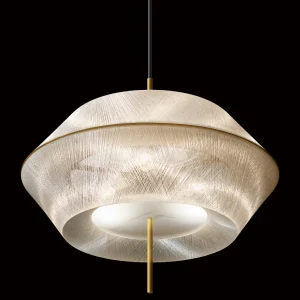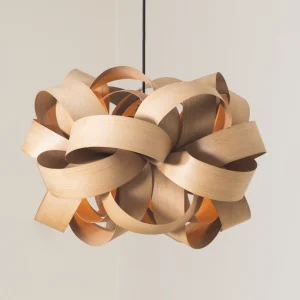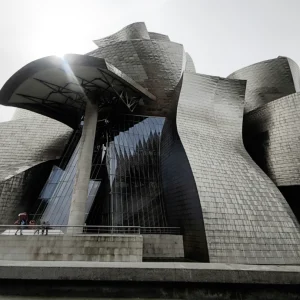All Images: Richard Chivers
THE HENRY MOORE INSTITUTE (HMI) in Leeds is a cultural landmark, a place for world-class exhibitions of historic and contemporary sculpture. It is also very much a place for research, as anyone who has had the pleasure of working in its amply daylit Sculpture Research Library will know. Here, displayed on warm wood shelves, ranged from floor to ceiling along every solid wall, are 30,000 books on sculpture, many emanating from the original library with which Moore established his Henry Moore Foundation in 1977 – along with an extensive archive of sculptors’ drawings and papers – with the ambition of furthering the appreciation of sculpture and its practitioners.
This is the first refurb that the HMI has enjoyed in the 31 years since it opened its dedicated space in 1993. It takes up one wing of a terrace of three Victorian merchants’ houses, all of it retrofitted by Dixon Jones, with Leeds Art Gallery occupying the bulk of the terrace.

The workshop is seen as key to changing visitor expectations, communicating the ambition for education and interaction
Dixon Jones’ scheme very much followed the psychology of the times, elevating the institute with a bold entrance – a glass door with a long, gentle ramp leading up to an imposing reception foyer, dominated by a massive desk. Beyond that was – and still is – a trio of excellent exhibition spaces of varying scales, including one lofty, double-height gallery. But by tucking the scholarship and admin activity away in cellular spaces on the three other floors, accessed off multiple corridors, the building’s core activities felt somewhat out of bounds, inwardfocused. It was definitely not communicating accessibility for all.
That atmosphere of introversion is completely reversed in a new scheme by Leedsbased architects Group Ginger. The entrance remains the same but the bulky reception desk has been whisked away. The main feature in that same foyer is now a large and curvy, comfortable seating island, upholstered in a pale, pink fabric. ‘We want your encounter with our facilities to be as warm, welcoming and enriching as possible,’ says director of the institute, Laurence Sillars. Greeting visitors in this way ‘allows people to sit down and get settled while they decide where to start’, says Sillars. A small, free-standing reception desk is placed to the back of the foyer. Bespoke joinery on the walls displays the compact but expertly curated retail offer of art magazines, sculpture books, posters and pencils.

The workshop is seen as key to changing visitor expectations, communicating the ambition for education and interaction
I ask Sillars how the brief evolved, and he says: ‘The single most important thing was to find an architect that could understand us being fundamentally an organisation for academic appreciation and research around sculpture, but also the need to make this whole building as inviting and functional a space as possible.’
In Group Ginger, they have clearly lucked out. For project architect Samantha Mooney, the key move was changing the suggested location of the institute’s proposal of a new educational workshop – the first fully functional facility for workshops and teaching – from basement to second floor, where there was mostly staff accommodation. She says: ‘From talking to staff, it didn’t seem appropriate to put it downstairs.
We were passionate about making this the gem of the building and reorganising the office spaces to enable this change.’ Group Ginger saw the workshop as key to changing visitor expectations, communicating the ambition for education and interaction. By placing it in a daylit former boardroom on the second floor – made substantially larger and dual-aspect thanks to the removal of a corridor – it becomes much more of a magnet. A dedicated break-out space has been created out of a former office to its rear. Acoustic panels of wood wool are placed on the ceiling, and the floor is a pale, wood-toned Marmoleum. ‘We wanted to create something that wasn’t a blank canvas, but had personality,’ says Mooney. Sillars seems to have got his wish, for this workshop to be: ‘A space as suitable for making as thinking.’ On the opposite side of the second floor lift/stair lobby we are shown vastly improved staff accommodation, which begins with a new, comfortable staff lounge featuring kitchenette, soft seating and shelving for some of the institute’s vintage sculpture and art magazines.
The offices beyond have been updated and upgraded. Previously three cellular rooms off a corridor, with staff toilets at the back, they now comprise two much larger, open-plan rooms with no corridor but circulation channelled via openings either side of the intervening wall. Attractive green/grey Cradle to Cradle carpeting adds to the feeling of quasi-domestic comfort, as do the wide, generous windows and soft-toned LED lighting. To the left of the second office are bookable, private meeting rooms, with a timber and glazed screen repurposed from the library foyer below to create a semi-transparent wall for the larger meeting room. Says Mooney: ‘Everything we can re-use we have re-used.’ That includes additional bookshelves from the library, which now slot in opposite an existing wall of shelves along the meeting room passageway.
 The Henry Moore Institute has undergone its first refurb since it opened its dedicated space in 1993
The Henry Moore Institute has undergone its first refurb since it opened its dedicated space in 1993
The seminar room in the basement is now an ideal space for medium-sized gatherings or screenings. Three top windows that had been covered up on the street side have been revealed, bringing welcome shafts of daylight into a basement space. The same grey-flecked, green carpeting as used in the staff quarters is deployed here to unify the whole building’s presentation. A very Henry Moore-ish, mid-century, sage green paint features on seminar room walls and also on the doors of the adjacent and updated, fully accessible toilet cubicles.
There are other, subtle but significant changes on the ground floor, beyond the refurbished foyer: a smaller break-out space for drop-in activities in the corridor and now great visibility through to the archive gallery beyond it, thanks to a wide, glazed doorway.
Environmental improvements include an upgrade of the roof, which has been re-tiled, and now features photovoltaic panels, which are predicted to save 13,000t of carbon over their life span. New heating, lighting and ventilation systems will improve both energy efficiency and comfort. With some deft moves, made for all the right reasons, it feels like Group Ginger has given a significant boost to Leeds’ contemporary art ecology, encouraging learners, thinkers and makers of all ages.





